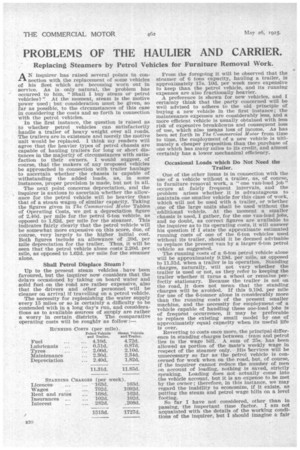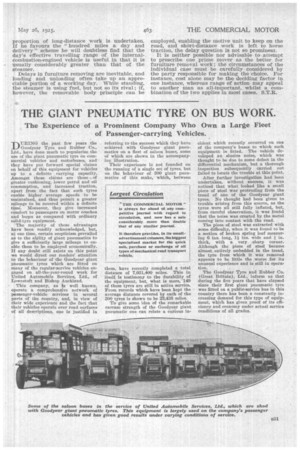PROBLEMS OF THE HAULIER AND CARRIER.
Page 14

Page 15

If you've noticed an error in this article please click here to report it so we can fix it.
Replacing Steamers by Petrol Vehicles for Furniture Removal Work.
AN inquirer has raised several points in connection with the replacement of some vehicles of his fleet which are becoming worn out in service. As is only natural, the problem has occurred to him, "Shall I buy steam or petrol vehicles? " At the moment, steam is the motive power used ; but consideration must be given, so far as possible, to the circumstances of this case in considering the costs and so forth in connection with the petrol vehicles.
In the first instance, the question is raised as to whether petrol vehicles can satisfactorily handle a trailer of heavy weight over all roads. The trailers are in existence and merely, the motive unit would be replaced. I think my readers will agree that the heavier types of petrol chassis are capable of hauling trailers for long or short distances in the majority of circumstances with satisfaction to their owners. I would suggest, of course, that the makers of any Proposed vehicles be approached in connection with trailer haulage to ascertain whether the chassis is capable of withstanding the added loads, as, in some instances, proper provision is made, but not in all.
The next point concerns depreciation, and the inquirer is anxious to ascertain whether the allowance for the petrol vehicle will be heavier than that of a steam wagon of similar capacity. Taking the figures given in The Commercial Motor Tables of Operating Costs, we get a depreciation figure of 2.40d. per mile for the petrol 6-ton vehicle, as opposed to 1.82d. per mile for the steamer. This indicates fairly clearly that the petrol vehicle will be somewhat more expensive on this score, due, of course, very largely to the higher initial cost. Both figures include an allowance of .20d. per mile depreciation for the trailer. Thus, it will be seen that the petrol vehicle alone costs 2.20d. per mile, as opposed to 1.62d. per mile for the steamer alone.
Shall Petrol. Displace Steam ?
Up to the present steam vehicles have been favoured, but the inquirer now considers that the delays occasioned by taking on board water and solid fuel on the road are rather expensive, also that the drivers and other personnel will be cleaner on arrival if travelling on a petrol vehicle.
The necessity for replenishing the water supply every 15 miles or so is certainly a difficulty to be contended with in a long day's run, and considerations as to available sources of supply are rather a worry in certain districts. The comparative operating costs will be roughly as follow :— From the foregoing it will be observed that the steamer of 6 tons capacity, hauling a trailer, is approximately 17s. 10d. per week more expensive to keep than the petrol vehicle, and its running expenses are also fractionally heavier.
A preference is shown for new vehicles, and I certainly think that the party concerned will be well advised to adhere to the old principle of buying a new vehicle in the first instance; the maintenance expenses are considerably less, and a more efficient vehicle is usually obtained with less risk of expensive breakdowns and consequent loss of use, which also means loss of income. As has been set forth in The Commercial Motor from time to time, the employment of a new vehicle is ultimately a cheaper proposition than the purchase of one which has many miles to its credit, and almost certainly has a lower mechanical efficiency.
Occasional Loads which Do Not Need the Trailer.
One of the other items is in connection with the use of a vehicle without a trailer, as, of course, in furniture removal work, a "one van-load job" occurs at fairly frequent intervals, and the problem arises whether it is advantageous to maintain one smaller vehicle for this class of work, which will not be used with a trailer, or whether one of the large units shall be used without the additional vehicle. At the moment a smaller chassis is used, 1 gather, for the one van-load jobs, and no doubt, as correct figures are available to the inquirer as to its operating costs, it will answer his question if I state the approximate estimated miming costs of one of the 6-ton vehicles used without its trailer, should it be deemed advisable to replace the present van by a larger 6-ton petrol vehicle as suggested.
The running costs of a 6-ton petrol vehicle alone will be approximately 9.19d. per mile, as opposed to 11.31d. when a trailer is in operation. Standing charges, naturally, will not vary whether the trailer is used or not, as they refer to keeping the trailer whether it turns a wheel or remains perfectly stationary. Because the trailer is not on the road, it does not mean that the standing charges will be avoided. If this 9.19d. per mile for use of the 6-tonner alone is considerably more than the running costs of the present smaller machine, and the necessity for employment -of a vehicle capable of handling these one-load jobs is of frequent occurrence, it may be preferable to replace the existing small model by one of approximately equal capacity when its useful life Is over.
Reverting to costs once more, the principal difference in standing charges between team and petrol lies in the wage bill. A sum of 25s. has been allowed as portion of the mate's weekly wage in respect of the steamer only. His '§ervices will be unnecessary so far as the petrol vehicle is concerned for work when on the road, but. of course, if the inquirer cannot reduce the number of men on account of loading, nothing is saved, strictly speaking. Loading does not actually come into the vehicle account, but it is an expense to be met by the owner ; therefore, in this instance, we may regard the inability to economize, if it exists, as putting the steam and petrol wage bills on a level footing. So far I have not considered, other than in passing, the important time factor. I am not acquainted with the details of the working conditions of the inquirer, but I should imagine a fair proportion of long-distance work is undertaken. If he favours the "hundred miles a day and delivery" scheme he will doubtless find that the day's effective travelling range of the internalcombustion-engined vehicle is useful in that it is usually considerably greater than that of the steamer.
Delays in furniture removing are inevitable, and loading and unloading often take up an appreciable portion of a working day. While standing, the steamer is using fuel, but not so its rival; if, however, the removable body principle can be employed, enabling the motive unit to keep on the road, and short-distance work is left to horse traction, the delay question is not so prominent.
It is neither possible nor advisable to attempt to prescribe one prime mover as the better for furniture removal work ; the circumstances of the Individual case must be carefully considered by the party responsible for making the choice. For instance, cost alone may be the deciding factor in one instance, whereas range of action may appeal to another Man as all-important, whilst a combination of the two applies in most cases. S.T.R.
































